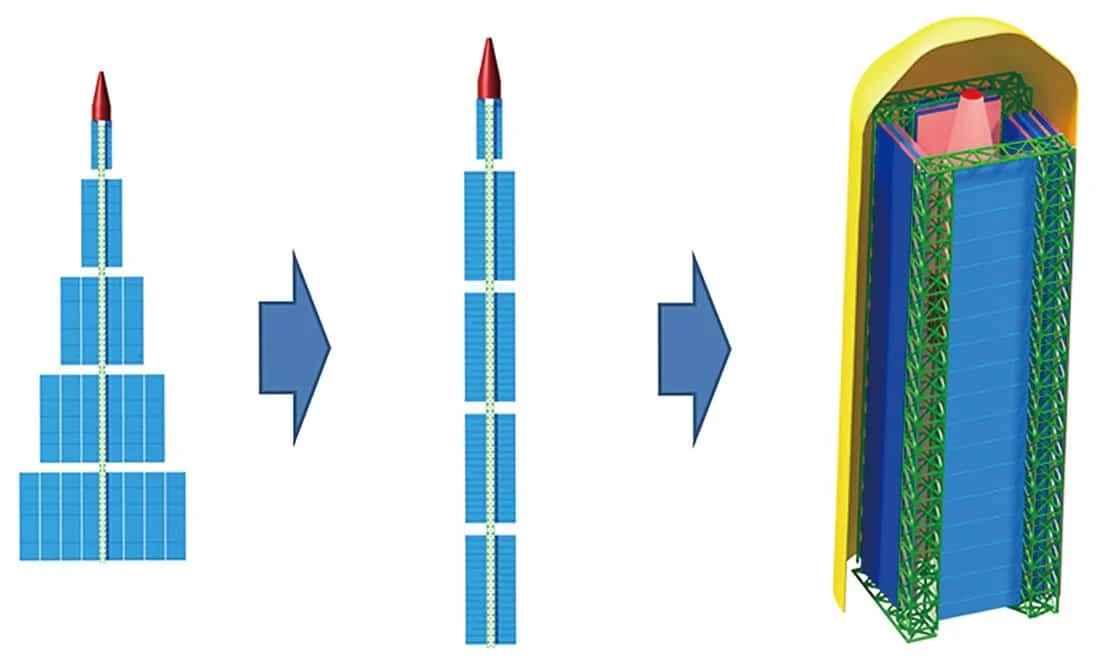Chinese scientists have evaluated their capabilities regarding the implementation of a promising space nuclear reactor project with an electrical capacity of one and a half megawatts. This is an installation with a liquid metal coolant and gas turbine that fits a mid-range launch vehicle in terms of weight and size. Several prototypes of its critical nodes have already undergone successful ground tests. However, many of the necessary technologies require either international involvement or intensive financing for further development.
Ambitious projects for the development of other planets and deep space, even at the preliminary development stage, face a major problem of large energy needs. Solar panels are beautiful, reliable and time-tested, but their specific power is small. The International Space Station carries 2,500 square meters of solar panels that produce an average of only 120 kilowatts of electricity. It is sufficient for the operation of the orbital laboratory, but high-efficiency electric drive units are out of the question.
There is actually no alternative to nuclear reactors for relatively fast manned flights to other planets and the outskirts of the solar system. Therefore, Chinese nuclear physicists are working on promising facilities that can ensure the competitiveness of the domestic nation in the new space race. This is a very difficult and expensive task, and its progress can be traced in a recent journal publication. Scientia Sinica Technological, This is reviewed. Its authors are employees of one and a half dozen leading scientific organizations of the Celestial Empire.
The article considers the design of a nuclear reactor with a cooling system based on a liquid metal coolant, gas turbine and heat pipes. Lithium serves as the heat carrier of the first circuit and the helium-xenon mixture of the second circuit. The heat pipes of the cooler are filled with potassium and mercury metal. The estimated thermal power is six megawatts, electrical power is up to one and a half megawatts net, another 50 kilowatts are spent on the internal needs of the reactor (pumps, heaters, control system).
In the section of the publication containing a preliminary analysis of current developments in the field of similar facilities, the authors explained why they chose this particular plan. In short, the specific power, reliability and weight ratio is optimal for the selected tasks and power range. Gas-phase reactors are arranged more simply (the heat carrier of the first circuit can be sent immediately to the gas turbine), but they require heavier protection and their operating temperatures are higher. Liquid metal reactors with heat pipes in the first circuit of heat exchange promise higher resistance to possible failures due to the simplicity of the design, but the specific power of such an installation will be much lower.
Chinese scientists are conducting a similar analysis on the remaining main nodes of the potential energy installation. The most interesting thing is the choice of the coolant of the first circuit – it is lithium, not potassium or sodium, which is usual for liquid metal reactors. Its specific heat capacity is several times higher, plus it remains liquid up to 1615 degrees. The higher the temperature of the hot part of the heat engine, the higher its efficiency compared to other equivalents.
There’s just one problem: No one has built such reactors yet, there are some developments in the US and Japan, but they haven’t moved beyond laboratories. That is why experts from the People’s Republic of China need to solve many of the most difficult tasks in the field of materials science.
Most of the articles of Chinese scientists are devoted to the possible difficulties of creation. To contain:
- development of technology for the production of vanadium-rhenium alloy and metal composites from it for pipelines of the first circuit (and methods of processing and welding such materials);
- testing and proving the separator (produced during irradiation) for separating helium from lithium in the first circuit, which must operate in weightlessness (previously they were tested only on Earth);
- Creating materials for the blades of a gas turbine that must operate continuously for decades at a temperature of 1500 degrees;
- development of technologies for the production of carbon-carbon composites for the main radiator of the cooling system (in the layers where heat pipes will be laid);
- Development of uranium-nitride ceramic nuclear fuel.
Chinese scientists particularly emphasize that these, along with many other incomplete knowledge and technologies, were developed abroad to some extent. The authors of the article identified several areas of work that require greater attention and funding from national research institutions. Only then, when such a space reactor is needed in 2035-2050, according to researchers, will China have it. Otherwise, the country risks falling behind other participants in the space race of the 21st century.
Many of the required technologies are already being developed. For example, recently (when not fully reported) a prototype of the heat exchanger between the first and second circuits of the future reactor passed ground tests. In the test, it was possible to check the corrosion-resistant pipeline of the lithium cooler, the electromagnetic pump and the helium-xenon turbine. Proof of the functionality of the concept has been achieved, further improvements are needed and the installation needs to be fully operational for a long time.













